Toggle Background Color
Know nothing about baseball? No problem, neither do I!
Seriously, as much as I love being around people who can calculate WAR and OPS+, I would much rather drink beer and watch a ball fly around for a couple hours than actually focus on the players or the plays happening below me. One of the reasons I love a good pitchers' duel is there's little danger of an errant home run landing in my gross $15 cheesy fries.
All that said, as little as I truly know about the sport I do love it dearly. Baseball on the radio is how I've gotten through many a long afternoon commute and not having it right now is just torture (although not having the commute is kinda nice).
If you're like me and just enjoy a lazy afternoon of watching people smack balls and run around bases then hopefully this is the thread for you. However, here's a bunch of baseball information to get you caught up.
History of the Game

There are a couple origin stories for baseball that have it starting any time between 1790-1840. The generally accepted (but largely discredited) one has Abner Doubleday playing the first game in 1839 at what is now known as Doubleday Field in Cooperstown NY, modern day home of the baseball hall of fame. While records of baseball exist before this and the man who made the claim would have been 5 at the time he said the legendary game took place (not to mention Doubleday himself probably would be surprised at his modern day fame as the father of baseball), it can't be denied that Doubleday had a significant impact on the evolution of the game. There is some evidence that he provided baseball equipment to his soldiers in the Civil War and enforced the New York baseball rules (invented in an exhibition game between the New York Knickerbockers and "the New York Nine") that would go on to become the standard of the nascent professional league. He certainly loved baseball but there's little evidence he viewed himself as particularly important to its creation or evolution into a professional sport.
While probably not the site of the first baseball game, Doubleday field has also weaved a thread throughout the history of the game. Originally a farm site, the baseball hall of fame purchased it in the 1920's and used it for professional spring exhibition games right up to 2007. One of my earliest memories was watching Nolan Ryan pitch in one of these games as a wee lad. They continue to use it in hall of fame and minor league exhibitions.
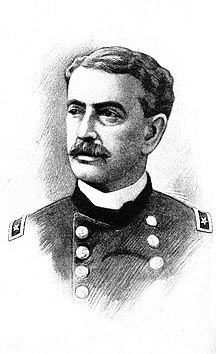
Like most things in baseball, Doubleday and his field were a myth based on a lie embraced and venerated as fact despite over a century of evidence to the contrary, and it has become its own wonderful tradition in the process.
Before talking about basics, I'd like to briefly address the Baseball Mindset

Baseball is a game of failure. The best single season offensive performance in the 140 year history of professional stat tracking was Ted Williams 1941 season, where he hit .406 and had an OBP of .553. What this means is when he was at the plate, he successfully got a hit (put the ball in play without recording an out) 40.6% of the time and got on base (got a hit or was walked/beaned by the pitcher) 55.3% of the time.
The best, most dominant single season performance in the history of the sport had a 44.7% failure rate. To be clear, nobody else has come close to these numbers and most players only get hits about 27% of the time. Ted Williams had an unbelievable career and, even missing 3 years of his prime to fight in world war 2, still holds the career on base percentage record.
What this means is that most of the time in this game, players will fail. Hitting a professionally pitched baseball is often called the hardest thing in all professional sports to do consistently. It isn't unusual for an all star to play multiple games in a row without a hit.
This also means that statistically pitchers will give up multiple hits per game, generally about 1 per 3-5 batters faced. It really isn't that surprising when an all star pitcher gives up 4 or 5 runs in a game although it is uncommon.
Baseball is a game of failure and if a player can't deal with striking out then they aren't going to be any good. This is where a lot of people really struggle, both fans and players. Yeah it sucks that big name outfielder just went 3 games without a hit, but with 162 games there are also going to be a bunch where he hits it over the wall several times. This is referred to as the whimsy of the baseball gods (mostly by me).
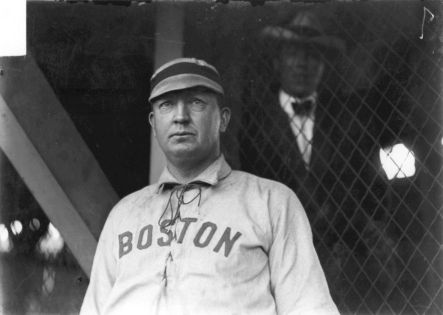
Cy Young holds two all time records. Most career wins with 511 and most career losses with 315.
Rules of the Game and Common Verbiage
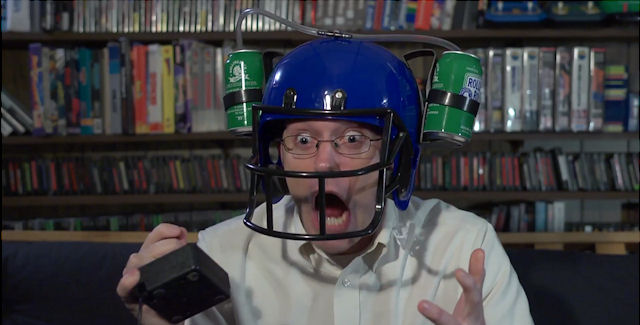
There is a ton to go through here, baseball has books and books of written rules (then you get into the unwritten rules that people seem to just make up as they go). I'll try to touch on the basics here but this is by no means an exhaustive list.
Baseball games are played between 2 groups of 25 (which become larger in September when minor league seasons end and the best performing players are "called up" to either help their professional clubs compete or give scouts a look at how they perform against professional pitching/hitting.
A baseball game is broken up into 9 innings. An inning refers to both teams having an opportunity to hit and defend. Each inning is broken up into 3 "outs" where the defending team has to get the hitters out and the hitters have to put the ball in play or otherwise get on base without getting out (or if they do, making those outs as productive as possible).
The goal of the hitting team is to move their players around the 3 bases and touch home plate without being tagged or "forced out". A force out occurs when a player is running from a base they can't run back to (because another player has to run to it) and the defender with possession of the ball steps on the base. Force outs can also occur if a fly ball (a ball hit in the air) is caught before touching the ground the the baserunner doens't "tag up", or return to, the base they were coming from.
If the bases are "loaded" (a runner on all 3 bases) players running to home base can be forced out.
Tags occur when the defender with posession of the ball touches the baserunner with the ball or with his glove (when the ball is in it) when the runner isn't currently touching a base. If the runner is touching a base with any part of their body they cannot be tagged out. This is why you see runners slide when not in a force out situation, though they will sometimes slide in an attempt to disrupt a defender throwing the ball to prevent a "double play" (two outs in one play).
The Pitcher is a guy who throws to the batter and tries to get them out. The pitcher can elicit outs by getting the batter to hit the ball at a fielder who can either catch the balls without it touching the ground (a fly or line out), tag the runner, or touch the base the runner is going to for a "force out".
The other way a pitcher can get an out is called a "strike out". Strikes occur when the pitcher throws the ball into an invisible square that runs the width of home plate and vertically runs between the hitter's knees and chest. Sounds reasonable? Good. It is also a strike if the batter swings and does not connect. If the batter connects with the ball but it flies backwards, this is a foul tip and counts as a strike. If the batter hits the ball and it lands outside the right or left lines on the field then that's also a strike unless there are already 2 strikes, in which case it remains at 2, unless it's an attempted bunt (bat remains roughly at midline rather than full swing) in which case it can be a strike out foul. The umpire squats behind the catcher and is supposed to recognize and yell out whether the pitch is a strike, foul, or a ball (a ball is a pitch that goes outside the invisible zone). In reality they probably spend most of the time peeing on the catcher's back.
If the pitcher can throw 3 strikes past the batter without throwing 4 balls or giving up a hit that's a strike out and counts as an out. If they get to 4 balls before reaching 3 strikes then it's a walk and the batter gets to trot slowly to first base while making eye contact with the pitcher.
Still with me? Good. Making fun of umpires no matter how hard they work, how right they are, or how thankless their job is generally is the safe way to go when watching the game with friends.
Team Rosters
There are two main units on every team, position players and pitching staff.
Position players are players who play in the field and the hitting lineup (more on that in a bit). A position player either plays every game (in which case they're called a starter), is "platooned" with another player to alternate starts depending on the stadium, team, and pitcher they're facing, or is a "bench player" who can be called in as a substitute for specific situations or to cover injury.
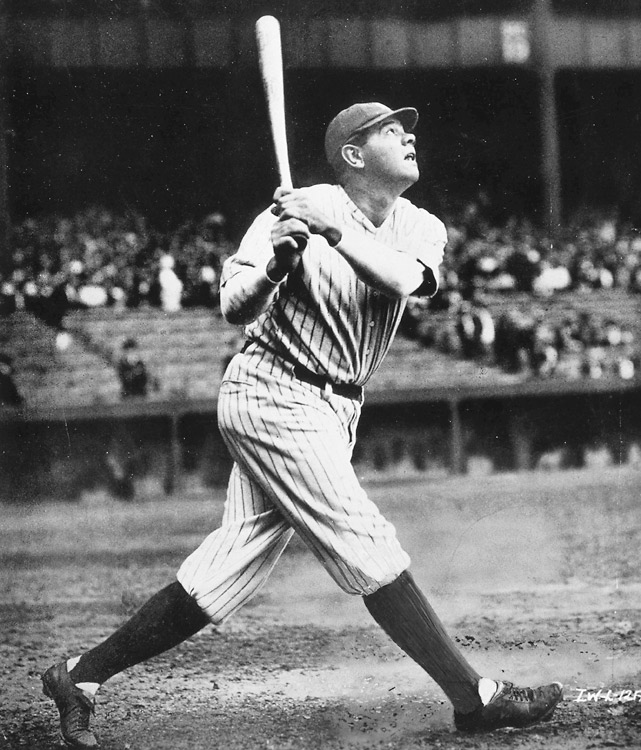
Starters are generally the team's best offensive players, the players either most likely to get a hit or most likely to get a lot of fly balls and home runs. These players get played regardless of who they're facing because they're just that good, and are typically started even when "cold" in order to get a chance to hit through their slump (a slump being a period of multiple games where the player either isn't getting hits or is getting a very low number of them, usually less than 20%).
Bench players are players who are very good at a specific aspect of the game but aren't as good as starters at every aspect. A bench will often have one or two fast players who can be substituted in if the coach wants to steal a base, a good hitter who can be substituted if the team needs a hit and a bad hitter is up to bat, and defensive replacements if the coach wants to protect a close lead late in a game.
Platoon players are more complex. There are certain advantages to having right and left handed hitters in a game depending on who's pitching and what stadium they're playing in, so coaches will often keep multiple players who are very good in specific game situations but are not as good in others. A platoon is usually referred to as 2 players who complement each others' strengths and weaknesses.
Lineup referrs to the order in which a team sets up its players to bat. People live and die by lineup order even though it isn't actually that important and making sure you have your best players in is much more vital regardless of the order they hit in. The quick and dirty lineup construction is you throw your fastest player first, then your best couple hitters, then the guys in the back who weren't good enough to be your fastest runners or best hitters.
A DH is a relatively new concept that is specific to the American League (AL) conference. A DH is a player the team can designate to only bat and not have to play defense or pitch, and will hit in place of the pitcher. While some hate the very concept, a lot of great players extended their careers by playing at DH.
Pitching is a very unique and complex skillset and most (though not all) pitchers are terrible hitters at the major league level. The DH was basically introduced to make games more exciting though some fans believe it ruins the strategy of the game.
When an AL team and an NL (National League) team play, the rules of the home team's ballpark will be in effect.
Pitching staff refers to the entire group of players who pitch the ball to hitters. This is broken into two main groups; starters and bullpen.
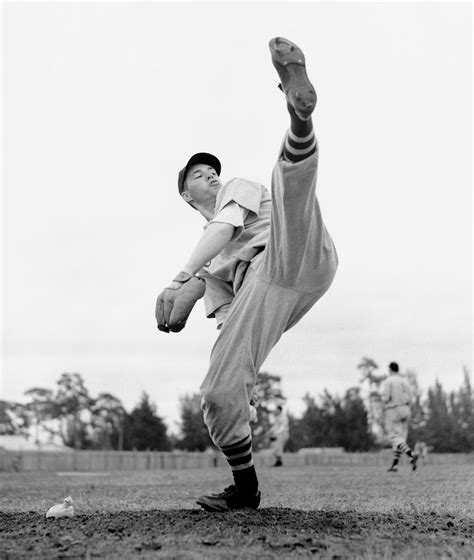
Starters are pitchers who begin the game and typically can throw a lot of pitches. It is normal for starters to pitch for 5-6 innings and a game where the starter pitches for 6 innings with 3 earned runs is referred to as a quality start, kind of the standard of what's considered a good performance by a starting pitcher.
Starters pitch out of what's referred to as a "rotation", usually 5 pitchers who will take turns starting games. Because they throw so many pitches it usually takes 5 days for a starter to recover between starts and there hasn't been anyone capable of being a major league level every day starter for decades. In the olden times some teams only had one starting pitcher (heck, some teams only had one pitcher).
A pitcher who starts with less than 5 days off since his last start is said to be on "short rest" and typically won't be able to throw as hard or as many innings.
Bullpen is typically used to refer to relief pitchers as a group. A relief pitcher is someone who will be brought into the game when the starter is tired or begins struggling. Relief pitchers, or relievers, are divided into long relievers, middle relievers, 8th inning setup, and closers. Not all teams use these designations or roles but generally this is the breakdown.
Long relievers are pitchers who can pitch almost as long as starters, usually 4-5 innings. Typically they are developmental pitchers who aren't quite at starter level but can be relied on for a bunch of outs. They can be called on to start if a member of the starting rotation is injured or the team wants to provide an aging starter an extra day off.
Middle relievers don't pitch quite as long and are generally used after the 5th inning to bail out a starter or long reliever. They can pitch a couple innings and generally throw harder and with more movement because they don't have to conserve stamina.
8th inning setup pitchers aren't directly modelled in Super Mega Baseball but in the game they are used in the 8th inning in a save situation to prevent the other team from scoring runs before they reach the closer.
Closing pitchers are pitchers who are mainly only used in the 9th inning, sometimes in the 8th if it's a "must win" game. Closers are brought on in save situations, a situation where your team is up by 3 runs or less, OR the tying run is at the plate. I believe a pitcher can also record a save if they pitch all 3 of the final innings regardless of the score but not sure on that one and fuck if I'm going to look it up. This is all convoluted enough as it is.
How This All Translates to the Game
Super Mega Baseball has always been a deceptively deep and complex baseball simulator behind a simple, arcade presentation, and it does a superb job of this. All of the rules above in addition to many I haven't mentioned are present, and again any exhaustive list would just be impractical. Instead I'll try to touch on the basics.
Gameplay in the new Franchise Mode (as well as basic gameplay mechanics)
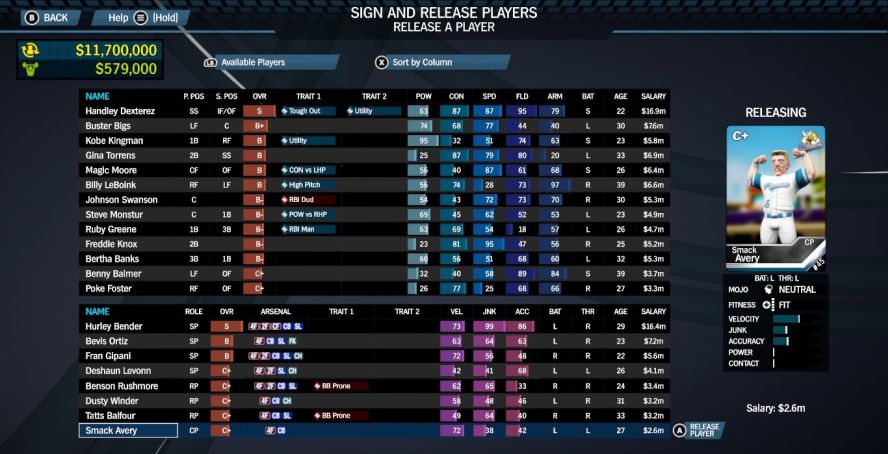
The above picture is of the Beewolves' roster. Each player has an overall grade, specific stats for 5 categories, and up to 2 traits.
Overall grade is a rough idea of how good that player will be. It is based on an average of individual stats but also any positive/negative traits, versatility (how many secondary positions they can play), and how their stats suit their position. A catcher with a high defense or arm rating will have a slightly higher overall grade than one with high speed rating, all else being equal.
Individual stats are how good that player is in those specific aspects of the game. These are in many ways more important than overall grade, especially when looking for someone to fill a specific role. When looking for a designated hitter defense and arm are essentially meaningless attributes, and in fact if you can find someone who is terrible defensively you can actually save money on the overall grade. For a first baseman they will almost never throw the ball and don't need to be particularly fast, but they do need good glove skills (defense) as dropped balls are depressingly common in this game.
Ego is the game's difficulty system, and it is amazing. There are 4 categories (hitting, pitching, baserunning, and fielding) with 99 different settings in each. It is incredibly powerful and tuneable to find exactly that right level of challenge for you.
Mojo is a stat boost or penalty that gets applied to a player based on their performance. A player who gets a big hit, makes a great defensive play, or gets a big strikeout will get a mojo boost. Players who screw up will receive a penalty. For Super Mega Baseball 2 players this system was significantly nerfed in 3 and is now capped based on team performance.
Traits are a brand new system that offers powerful situational boosts and penalties to players. K man offers a bonus to pitchers in 2 strike counts, while K dud gives a penalty (for example).
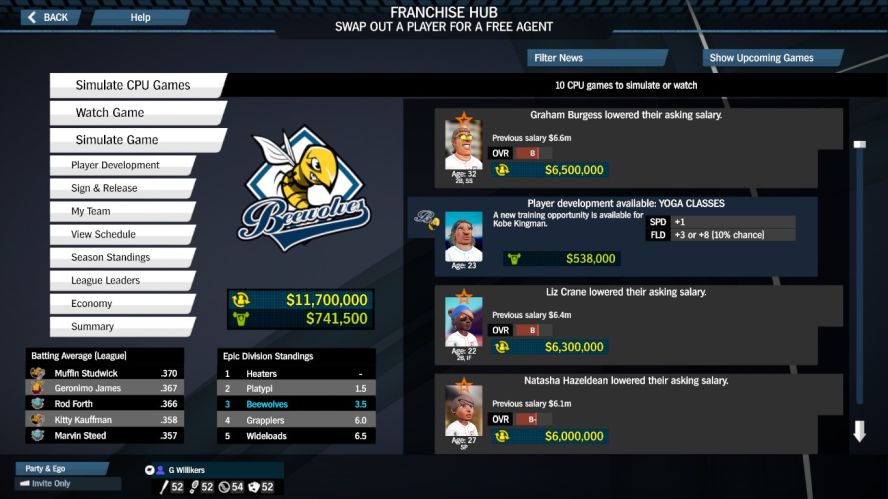
This is the Franchise home screen. You can access your roster to set lineups, choose starting pitcher for the next game, look at player development opportunities (more in a moment), and sign new free agents to upgrade your roster.
Salary Cap
The Salary Cap is the team's total budget for payroll and development. In standard franchises this is always set to 140 million, while in custom franchises this is set to the most expensive team's total payroll. Incidentally this team has a powerful customization system that allows you to completely build out a team, creating your own logo, uniforms, players, and even league structures.
Free Agents
If you have the cap space, you can release one of your current players to sign a better one. If you are low on cap space and want to make more, you can release an expensive player and sign a cheap one (this is "selling" or "unloading cap").
All players are playing on one year deals that are renewed year to year. This means you can terminate the contracts with no penalty at any time, and in return the players can decide to retire or test free agency at the end of the year. In practice this means at the end of the year we will generally lose 2-8 players and need to replace them.
When a player leaves they will usually demand massive contracts and as time progresses, either in offseason negotiating rounds or as games are played, the demands will come down. Other teams will also actively be signing free agents or releasing cap space and if you aren't aggressive they can grab a free agent you were eyeing. If a player spends a long time on the free agent list they will decide to retire and eventually be replaced by a rookie.
Player Development
New to Super Mega Baseball 3 is the ability to develop your player's attributes. Player development costs development funds, which are paid out after each game equal to total salary cap space divided by number of games. Development opportunities are permanent increases to stats that also can carry the possibility of bonuses and can confer positive or negative stats. All of the risks and opportunities of a given development activity will be apparent before purchasing it.
This can be a bit of a risk/reward situation for a couple reasons. Obviously there's the risk with some of these of conferring a bad trait which can ruin a young player. There's also the risk that if you focus development on specific players they might decide to leave and demand more money.
Personally I like the risk/reward aspects of developing players and signing agents but a lot of people are asking for long term contracts or a franchise tag in the game. We'll cross that bridge if it ever comes up.
Conclusion
Hopefully this is enough of a primer for you to feel like you can participate and enjoy this thread. The last thing I want is for anyone to feel left behind by the complexity of the game so if you have any questions or feedback please don't hesitate to ask. To conclude, here's a picture of me winning the championship with the Sand Cats.










